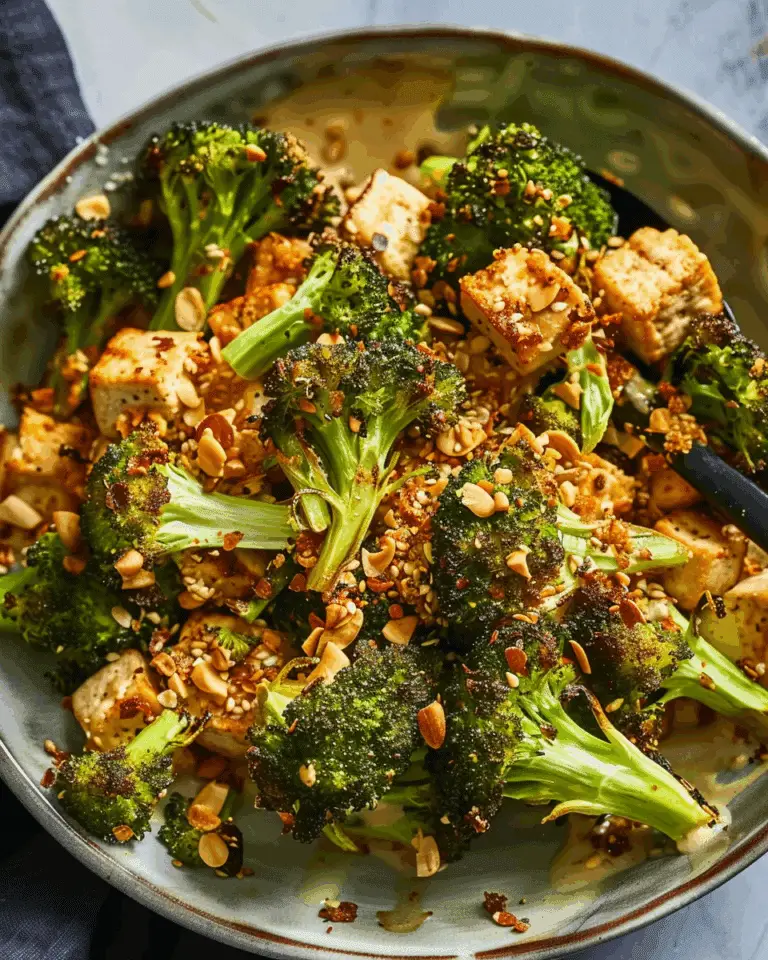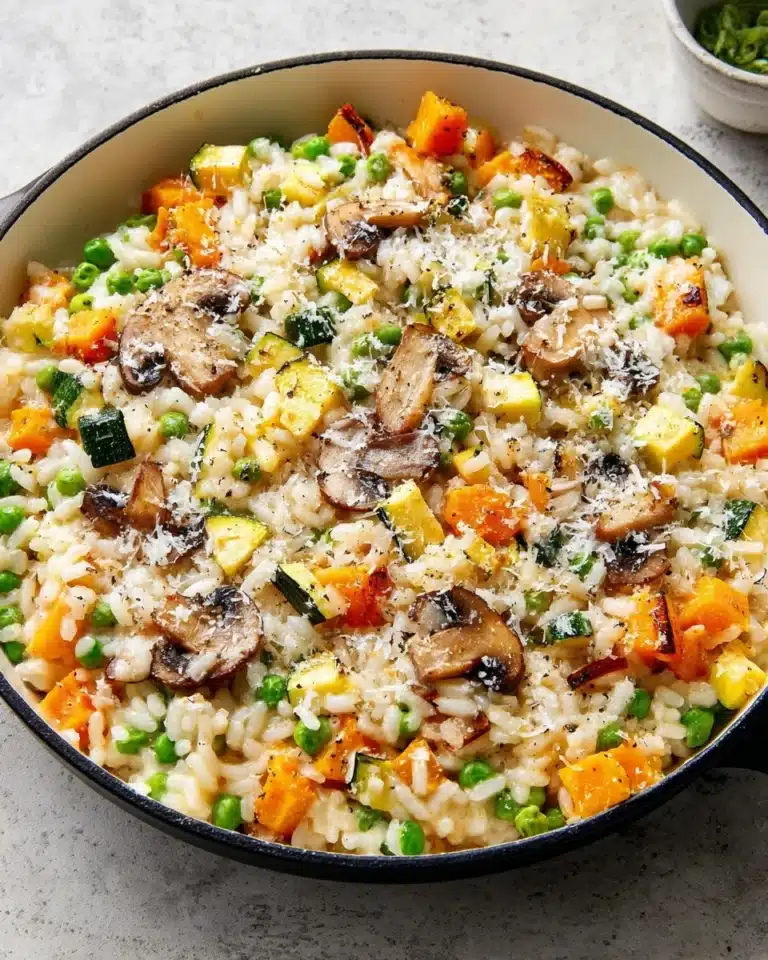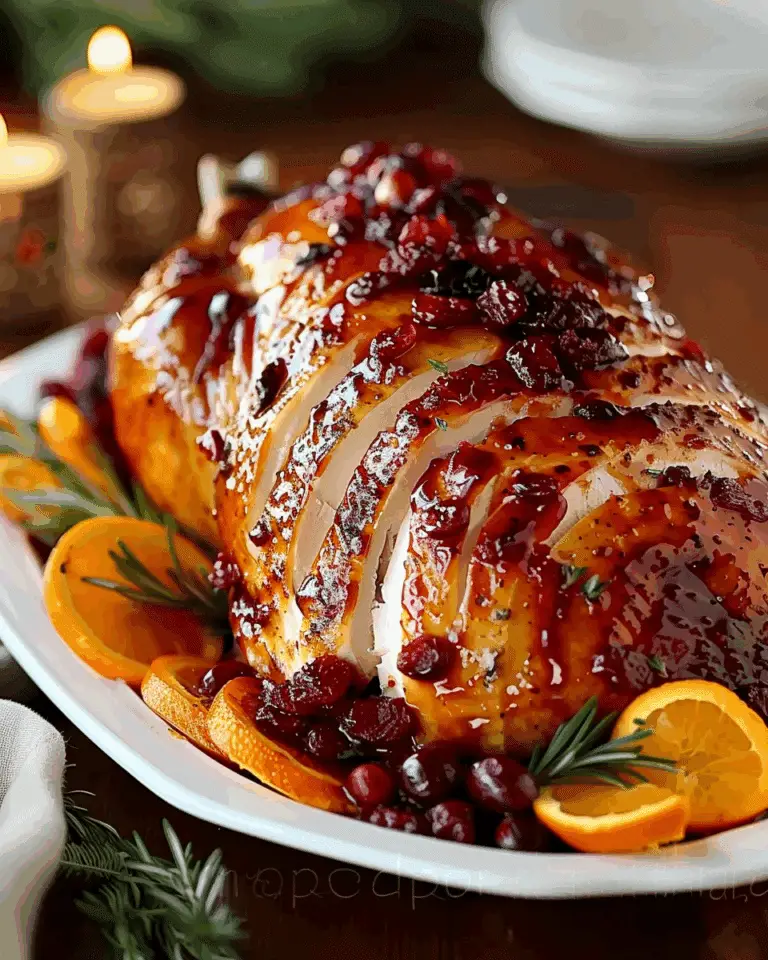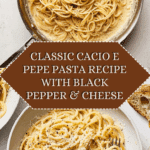If you’re on the hunt for a pasta dish that’s the perfect harmony of simplicity and bold flavor, then look no further than Cacio E Pepe. This classic Italian recipe showcases just a few pantry staples—cheese, pepper, pasta, and a touch of butter and olive oil—that come together in a divine dance of creamy, peppery goodness. Each bite bursts with the warmth of freshly cracked black pepper and the sharp, tangy embrace of Pecorino and Parmigiano-Reggiano cheeses, making Cacio E Pepe an unforgettable, comforting meal that feels effortlessly elegant.
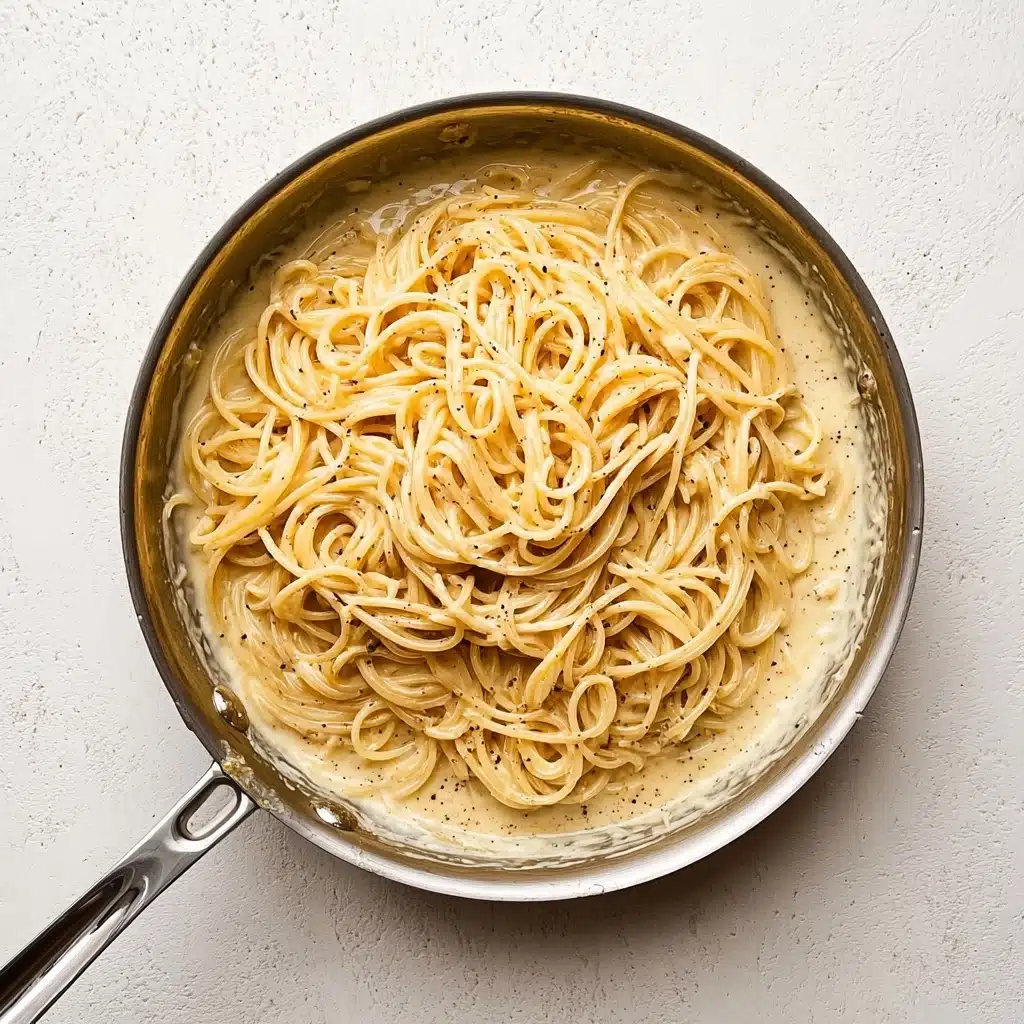
Ingredients You’ll Need
Creating Cacio E Pepe is all about quality ingredients that each play a vital role in the dish’s final character. With just a handful of essentials, the magic happens through balance and technique, so choose the best you can find for maximum flavor.
- 12 ounces spaghetti or bucatini: The pasta acts as the perfect vehicle to carry the creamy cheese and pepper sauce.
- 2 tablespoons extra-virgin olive oil: Adds a subtle fruity richness that ties the sauce together.
- 2 tablespoons unsalted butter: Brings silky smoothness without overpowering the delicate flavors.
- 2 teaspoons freshly cracked black pepper, plus more to taste: The star spice providing fiery heat and aromatic depth.
- 1 cup finely grated Parmigiano-Reggiano or Grana Padano: Introduces a nutty, savory note that melts beautifully.
- 1 ½ cups finely grated Pecorino Romano: Offers a tangy, salty punch that makes this dish so distinctive.
How to Make Cacio E Pepe
Step 1: Cook the Pasta to Perfection
Start by bringing a large pot of salted water to a rolling boil. Adding the right amount of salt to your water is crucial—it seasons the pasta from the inside out. Drop in your spaghetti or bucatini and cook it until it’s just barely al dente, which means it should still have a little bite. This step ensures that your noodles won’t overcook later when mixed with the sauce. Remember to save one full cup of the pasta water before draining; this starchy liquid is key to helping your sauce marry with the pasta seamlessly.
Step 2: Create the Pepper-Infused Base
While your pasta cooks, gently warm the olive oil and 1 tablespoon of butter in a large skillet over medium heat. Once the butter fully melts, sprinkle in the freshly cracked black pepper and swirl the pan as the aroma builds—it takes about a minute. This elevates the pepper, releasing its essential oils and infusing the base of your sauce with that signature peppery kick that makes Cacio E Pepe so irresistible.
Step 3: Bring It All Together
Pour in ½ cup of the reserved pasta water and bring your peppered butter and oil mixture to a light simmer. Lower the heat, then add your drained pasta directly into the skillet along with the remaining tablespoon of butter, the Parmigiano-Reggiano, and Pecorino Romano. Toss everything vigorously so the cheeses melt gently, coating every strand while the starchy water helps create a rich, silky sauce. If you notice the sauce getting too thick or dry, gradually add a bit more pasta water, just a tablespoon at a time, until your noodles are glistening and beautifully sauced.
Step 4: Serve It Right
Transfer your Cacio E Pepe to warm bowls and finish with an extra sprinkle of Parmigiano-Reggiano and a pinch more freshly cracked black pepper. This final flourish balances and brightens the flavors, inviting you to dive into the comforting, cheesy goodness that only this dish can deliver.
How to Serve Cacio E Pepe
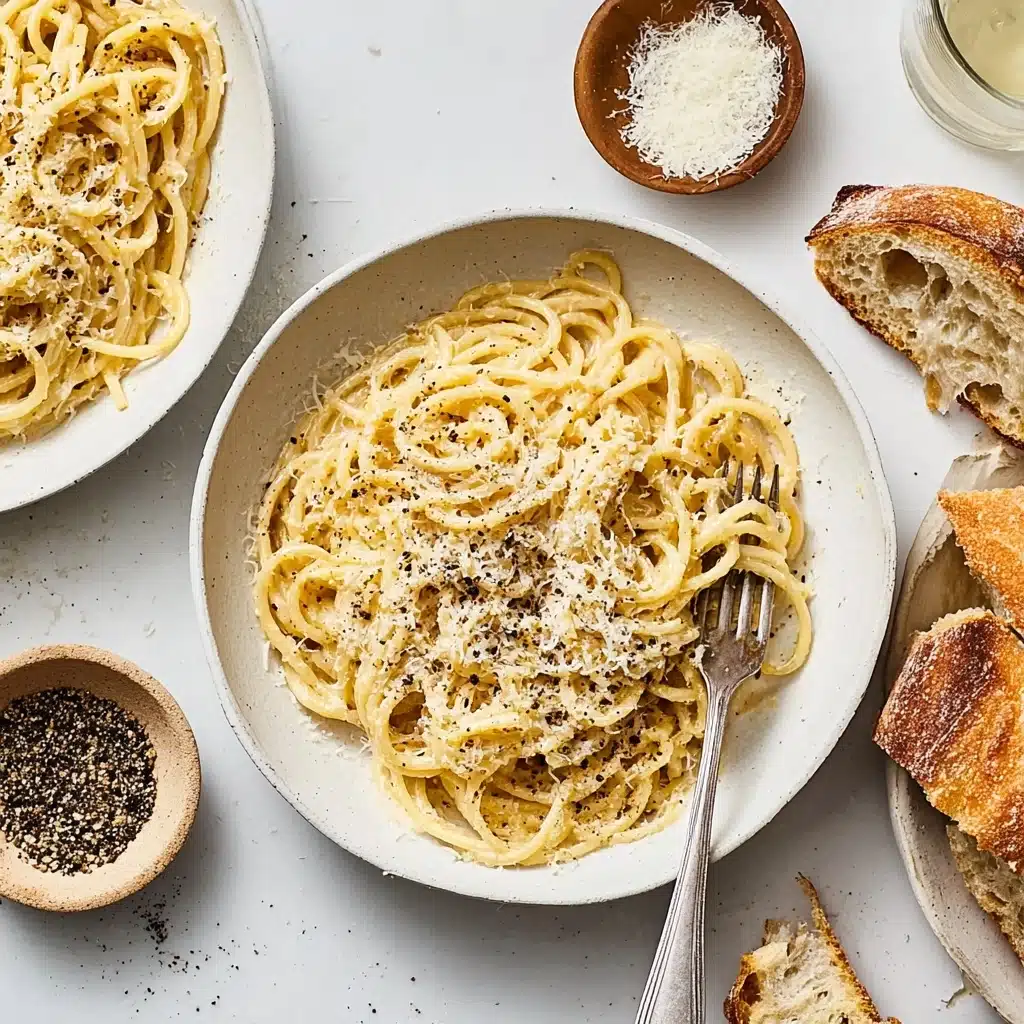
Garnishes
While this dish shines wonderfully on its own, simple garnishes can take your Cacio E Pepe to the next level. Try adding a few twists of extra fresh cracked black pepper on top for a vibrant aroma and a touch more heat. Fresh herbs like chopped parsley or a drizzle of good quality extra-virgin olive oil can add a pop of green and a lovely freshness without overshadowing the classic flavors.
Side Dishes
Cacio E Pepe pairs beautifully with light, crisp sides that complement rather than compete. A crunchy arugula salad dressed with lemon and olive oil provides a peppery contrast, while roasted vegetables like asparagus or zucchini add satisfying texture. If you want to keep things indulgent, serve it alongside warm, crusty Italian bread to soak up any extra sauce.
Creative Ways to Present
For an impressive dinner party or a cozy meal at home, try twirling portions of Cacio E Pepe into neat nests on plates for a restaurant-style presentation. You could also serve it family-style in a large shallow bowl garnished with a generous dusting of cheese and pepper, inviting everyone to dig in. For a twist, sprinkle some toasted breadcrumbs on top to introduce a delightful crunch that contrasts the silky noodles.
Make Ahead and Storage
Storing Leftovers
If you find yourself with leftovers, keep them in an airtight container in the refrigerator. The sauce will thicken as it cools, so it’s best enjoyed within one to two days for optimal texture and taste. Be sure to refrigerate promptly to keep everything fresh.
Freezing
Cacio E Pepe does not freeze well due to the nature of the cheesy sauce, which can separate and become grainy. For the best experience, avoid freezing; instead, plan on enjoying your dish fresh. If you must store for longer, freeze the pasta and sauce separately, reheating carefully when ready.
Reheating
Reheat gently on the stovetop over low heat, adding a splash of pasta water to revive the sauce. Avoid microwaving if possible, as it can cause the cheese to clump. Stir continuously until the sauce loosens and the noodles are warmed through, bringing back the luscious texture you crave from freshly made Cacio E Pepe.
FAQs
What pasta works best for Cacio E Pepe?
Spaghetti and bucatini are traditional choices because their shape holds the creamy sauce beautifully. Bucatini’s hollow center also traps the cheese and pepper, delivering an extra burst of flavor.
Can I make Cacio E Pepe vegan or dairy-free?
Traditional Cacio E Pepe relies on cheese and butter for its signature taste, but you can experiment with vegan cheese alternatives and plant-based butter to create a dairy-free version. Just keep in mind the flavor profile will be quite different.
Why should I save the pasta water?
Reserving pasta water is essential because it contains starch released during cooking. This starch helps bind the cheese and pepper to the noodles, creating the creamy sauce that defines Cacio E Pepe.
Is freshly cracked black pepper necessary?
Absolutely! Freshly cracked black pepper has a much brighter, more potent aroma and flavor than pre-ground pepper. It elevates the dish and is a key to authentic Cacio E Pepe.
Can I use a different cheese if I don’t have Pecorino Romano?
While Pecorino Romano is traditional and adds a sharp, salty tang, Parmigiano-Reggiano or Grana Padano can be used on their own or together. Each cheese brings its own nuance, so feel free to adjust to your taste.
Final Thoughts
With its effortless elegance and soulful simplicity, Cacio E Pepe is a dish that invites you to slow down and savor every bite. Whether you’re cooking for a casual weeknight dinner or looking to impress with minimal fuss, this recipe delivers genuine Italian comfort that never goes out of style. Give it a try and experience how just a few humble ingredients can come together to create a memorable masterpiece on your plate.
Print
Cacio E Pepe Recipe
- Total Time: 20 minutes
- Yield: 4 servings
- Diet: Vegetarian
Description
Cacio e Pepe is a classic Italian pasta dish known for its simplicity and rich flavor, combining just a few ingredients—spaghetti or bucatini, black pepper, Pecorino Romano, and Parmigiano-Reggiano cheese. This creamy, peppery dish is quick to prepare and perfect for a comforting yet elegant meal.
Ingredients
Pasta
- 12 ounces spaghetti or bucatini
Sauce
- 2 tablespoons extra-virgin olive oil
- 2 tablespoons unsalted butter
- 2 teaspoons freshly cracked black pepper, plus more to taste
- 1 cup finely grated Parmigiano-Reggiano or Grana Padano, plus more for serving
- 1 ½ cups finely grated Pecorino Romano
Instructions
- Cook the pasta: Bring a large pot of salted water to a boil over high heat. Add the pasta and cook until just barely al dente. Reserve 1 cup of the pasta water and then drain the pasta.
- Prepare the pepper sauce: Meanwhile, heat the olive oil and 1 tablespoon of the butter in a large skillet over medium heat. Once the butter has melted, add the freshly cracked black pepper and cook while swirling the pan until fragrant, about 1 minute.
- Combine pasta and sauce: Add ½ cup of the reserved pasta water to the skillet and bring it to a simmer. Reduce the heat to low, then add the cooked pasta, the remaining 1 tablespoon of butter, Parmigiano-Reggiano, and Pecorino Romano cheese. Toss everything together until the cheese melts and the pasta is tender and evenly coated. Add more reserved pasta water, one tablespoon at a time, if the sauce needs loosening.
- Serve: Plate the pasta and sprinkle with additional Parmigiano-Reggiano and freshly cracked black pepper to taste. Serve immediately for best flavor and texture.
Notes
- Use freshly cracked black pepper for the best flavor and aroma.
- Be careful not to overcook the pasta; it should be just barely al dente to absorb the sauce well.
- Gradually add the pasta water to achieve a creamy sauce consistency.
- You can substitute Pecorino Romano with Grana Padano for a milder taste.
- This dish is best enjoyed immediately as the sauce thickens upon standing.
- Prep Time: 5 minutes
- Cook Time: 15 minutes
- Category: Main Course
- Method: Boiling, Sautéing, Tossing
- Cuisine: Italian
Nutrition
- Serving Size: 1 cup
- Calories: 410
- Sugar: 1 g
- Sodium: 520 mg
- Fat: 18 g
- Saturated Fat: 9 g
- Unsaturated Fat: 8 g
- Trans Fat: 0 g
- Carbohydrates: 50 g
- Fiber: 2 g
- Protein: 16 g
- Cholesterol: 30 mg



